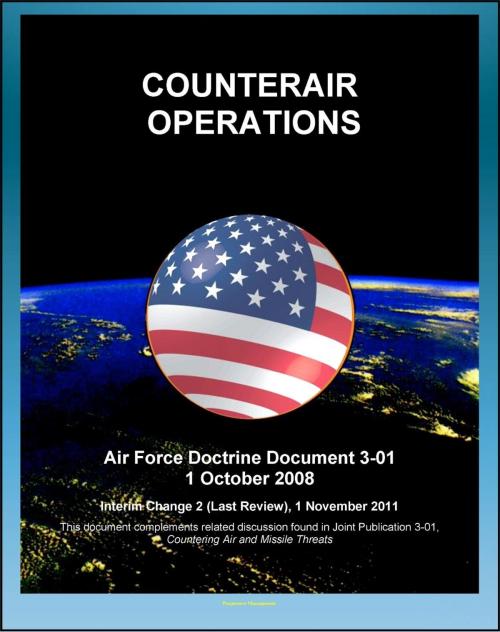Air Force Doctrine Document 3-01, Counterair Operations: USAF Command and Control, Counterair Planning, Execution, Assessment
Nonfiction, Science & Nature, Technology, Aeronautics & Astronautics, History, Military, Aviation| Author: | Progressive Management | ISBN: | 9781476292786 |
| Publisher: | Progressive Management | Publication: | April 11, 2012 |
| Imprint: | Smashwords Edition | Language: | English |
| Author: | Progressive Management |
| ISBN: | 9781476292786 |
| Publisher: | Progressive Management |
| Publication: | April 11, 2012 |
| Imprint: | Smashwords Edition |
| Language: | English |
The mission of the United States Air Force is to fly, fight, and win in air, space, and cyberspace. A crucial part of achieving that mission involves obtaining and maintaining superiority in the air domain. That domain, defined for the first time in this publication, is the area, beginning at the Earth's surface, where the atmosphere has a major effect on the movement, maneuver, and employment of joint forces. Within that domain, forces exercise degrees of control or levels of influence, characterized as parity, superiority, or supremacy. The US has enjoyed at least air superiority in all conflicts since the Korean War. The US will probably retain that superiority in today's ongoing conflicts, but the prospect of near-peer competitors in the not-too-distant future raise the possibility of air parity - a condition in the air battle in which one force does not have air superiority over others - or even conceding superiority to the adversary if Air Force forces are not properly employed.
Our possession of air superiority helps enable joint forces to dominate adversary operations in all domains and to achieve a wide range of cross-domain effects. Unless we can freely maneuver in the air while denying the enemy the ability to do the same, we do not have superiority. Therefore, this publication addresses how the commander of Air Force forces can best employ his assets within a joint force to achieve control in the air domain to enable the overall joint force effort.
Counterair is more than just force protection or air and missile defense. It also includes offensive actions against an enemy's capabilities, allowing us to seize the initiative and force the adversary into a defensive posture. Furthermore, counterair is executed by more than just air assets. Counterair is a joint, multinational, and interagency team effort, comprising a combination of command and control systems, intelligence, surveillance, and reconnaissance systems, aircraft and missile systems in air-to-air and air-to-ground roles, and surface-to-air defense weapons.
The effect of air superiority is not normally an end unto itself. Air superiority provides enormous military advantages, allowing the joint force greater freedom of action to carry out its assigned missions (freedom to attack) while minimizing its vulnerability to enemy detection and attack (freedom from attack). The success of any major air, land, or maritime operation may depend on the degree of air superiority achieved. This Air Force doctrine document provides guidance for designing, planning, integrating, coordinating, executing, and assessing counterair operations. It provides operational doctrine to gain and maintain control of the air. As such, it focuses on how air forces can be organized and employed to successfully conduct counterair operations.
Contents: Chapter One - Counterair Fundamentals * Chapter Two - Organization And Command And Control (C2) * Chapter Three - Counterair Planning, Execution, And Assessment The Counterair Framework
The mission of the United States Air Force is to fly, fight, and win in air, space, and cyberspace. A crucial part of achieving that mission involves obtaining and maintaining superiority in the air domain. That domain, defined for the first time in this publication, is the area, beginning at the Earth's surface, where the atmosphere has a major effect on the movement, maneuver, and employment of joint forces. Within that domain, forces exercise degrees of control or levels of influence, characterized as parity, superiority, or supremacy. The US has enjoyed at least air superiority in all conflicts since the Korean War. The US will probably retain that superiority in today's ongoing conflicts, but the prospect of near-peer competitors in the not-too-distant future raise the possibility of air parity - a condition in the air battle in which one force does not have air superiority over others - or even conceding superiority to the adversary if Air Force forces are not properly employed.
Our possession of air superiority helps enable joint forces to dominate adversary operations in all domains and to achieve a wide range of cross-domain effects. Unless we can freely maneuver in the air while denying the enemy the ability to do the same, we do not have superiority. Therefore, this publication addresses how the commander of Air Force forces can best employ his assets within a joint force to achieve control in the air domain to enable the overall joint force effort.
Counterair is more than just force protection or air and missile defense. It also includes offensive actions against an enemy's capabilities, allowing us to seize the initiative and force the adversary into a defensive posture. Furthermore, counterair is executed by more than just air assets. Counterair is a joint, multinational, and interagency team effort, comprising a combination of command and control systems, intelligence, surveillance, and reconnaissance systems, aircraft and missile systems in air-to-air and air-to-ground roles, and surface-to-air defense weapons.
The effect of air superiority is not normally an end unto itself. Air superiority provides enormous military advantages, allowing the joint force greater freedom of action to carry out its assigned missions (freedom to attack) while minimizing its vulnerability to enemy detection and attack (freedom from attack). The success of any major air, land, or maritime operation may depend on the degree of air superiority achieved. This Air Force doctrine document provides guidance for designing, planning, integrating, coordinating, executing, and assessing counterair operations. It provides operational doctrine to gain and maintain control of the air. As such, it focuses on how air forces can be organized and employed to successfully conduct counterair operations.
Contents: Chapter One - Counterair Fundamentals * Chapter Two - Organization And Command And Control (C2) * Chapter Three - Counterair Planning, Execution, And Assessment The Counterair Framework















